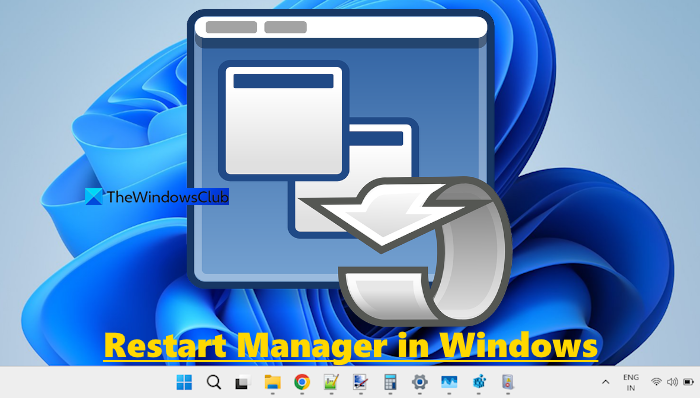Starting with Windows Vista and Windows Server 2008, Microsoft has introduced a new application called the Restart Manager (or Restart Manager API) to eliminate or reduce the number of system restarts that are required to complete an installation or update. Restart Manager consists of a single DLL that can be loaded by applications to access the Restart Manager API. In this post, we will talk about the Restart Manager in Windows 11/10 and how it works.

Windows Restart Manager
Let’s say, if an application or Windows 11/10 itself, needs to update itself, the Installer calls upon the Restart Manager, to see if it can clear that part of the system so that it can be updated. If it can do that, it does so, and this happens without a reboot.
And if this cannot be done, then what it does is that it takes a snapshot of the system, together with the applications, at that very moment, and then it just updates and restarts the application, or in the case of an operating system update, it will bring the operating system back exactly where it was, after the reboot!
Let’s say a user is working on a Word document, say, thewindowsclub.doc and the cursor is on coordinates, say col 5, line 7. And, the system has to update either or both of them.
The Restart Manager does 5 things:
- It looks for all processes that are using this file.
- It then shuts down such processes
- Applies the updates
- Restarts those processes
- Preserves the exact state of each running process and then restores that state upon restarting the process.
Freeze Drying
This feature will re-open a closed document and restore the cursor to say, col 5, line 7, the exact position it was in when the document was closed. This is called the Freeze drying of the program.
The Restart Manager works in tandem with Microsoft Update, Windows Update, Microsoft Windows Server Update Services, Microsoft Software Installer and Microsoft Systems Management Server, to detect processes that have files in use and to stop and restart services without the need to restart the entire machine. The full functionality of ‘Restart Manager’ is presently available only to select applications written to take advantage of it. Microsoft Office is one of them.
Side-by-side compliant Dll files
For those programs that do not support Restart Manager, Windows has introduced what is called Side-by-side compliant DLLs. This enables a program to write a new version of a DLL to the hard disk, even if the old one is still in use. Only when you shut down the program does Windows replace the old version with the new one!
One, therefore, sees fewer post-update reboots in Windows 11/10.
More at MSDN.
How do you restart Windows Manager in Windows 11/10?
If you want to restart File Explorer (previously known as Windows Explorer) on your Windows 11/10 computer, open the task manager window. Access the Processes tab and look for the Windows Explorer process. Right-click on that process and use the Restart option. Alternatively, you can also create a BAT file and make a desktop shortcut to restart File Explorer quickly.
What is Event ID 10001 Restart Manager?
The Event ID 10001 is related to the source application RestartManager. This event log appears under the Application section of Windows Logs in the Event Viewer. It is created when the Restart Manager ends a session successfully. There is no further action needed from the user end.
Read next: How to open and use Windows Services Manager (Services.msc).
Leave a Reply